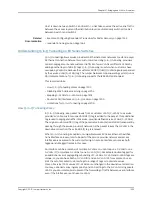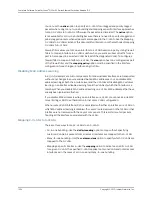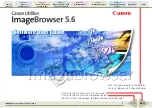
If you configure multiple methods, the switch gives priority to mapping a specific interface,
then to many-to-one bundling, and last to all-in-one bundling. However, you cannot have
overlapping rules for the same C-VLAN under a given approach.
•
All-in-One Bundling on page 1295
•
Many-to-One Bundling on page 1295
•
Mapping a Specific Interface on page 1295
All-in-One Bundling
All-in-one bundling maps all packets from all access interfaces to the S-VLAN. All-in-one
bundling is configured using the
dot1q-tunneling
option without specifying customer
VLANs.
When all-in-one bundling is used, all packets leaving the C-VLAN, including untagged
and priority tagged packets, enter the S-VLAN.
Many-to-One Bundling
Many-to-one bundling is used to specify which C-VLANs are mapped to an S-VLAN.
Many-to-one bundling is configured using the
customer-vlans
option.
Many-to-one bundling is used when you want a subset of the C-VLANs on the access
switch to be part of the S-VLAN. When using many-to-one bundling, untagged and priority
tagged packets can be mapped to the S-VLAN when the
native
option is specified along
with the
customer-vlans
option.
Mapping a Specific Interface
Use the mapping a specific interface approach when you want to assign an S-VLAN to
a specific C-VLAN on an interface. The mapping a specific interface configuration only
applies to the configured interface, not to all access interfaces as in the cases of the
all-in-one bundling and many-to-one bundling approaches. The mapping a specific
interface approach is configured using the
mapping
option to indicate a specific S-VLAN
for a given C-VLAN.
The mapping a specific interface approach has two suboptions for treatment of traffic:
swap and push. When traffic that is mapped to a specific interface is pushed, the packet
retains its tag as it moves between the S-VLAN and C-VLAN and an additional VLAN tag
is added to the packet. When traffic that is mapped to a specific interface is swapped,
the incoming tag is replaced with a new VLAN tag. Using the
swap
option is also referred
to as VLAN ID translation.
It might be useful to have S-VLANs that provide service to multiple customers. Each
customer will typically have its own S-VLAN plus access to one or more S-VLANs that
are used by multiple customers. A specific tag on the customer side is mapped to an
S-VLAN. Typically, this functionality is used to keep data from different customers
separate or to provide individualized treatment of the packets on a certain interface.
Routed VLAN Interfaces on Q-in-Q VLANs
Routed VLAN interfaces (RVIs) are supported on Q-in-Q VLANs.
1295
Copyright © 2010, Juniper Networks, Inc.
Chapter 57: Bridging and VLANs—Overview
Summary of Contents for JUNOS OS 10.3 - SOFTWARE
Page 325: ...CHAPTER 17 Operational Mode Commands for System Setup 229 Copyright 2010 Juniper Networks Inc ...
Page 1323: ...CHAPTER 56 Operational Mode Commands for Interfaces 1227 Copyright 2010 Juniper Networks Inc ...
Page 2841: ...CHAPTER 86 Operational Commands for 802 1X 2745 Copyright 2010 Juniper Networks Inc ...
Page 3367: ...CHAPTER 113 Operational Mode Commands for CoS 3271 Copyright 2010 Juniper Networks Inc ...
Page 3435: ...CHAPTER 120 Operational Mode Commands for PoE 3339 Copyright 2010 Juniper Networks Inc ...
Page 3529: ...CHAPTER 126 Operational Mode Commands for MPLS 3433 Copyright 2010 Juniper Networks Inc ...
















































